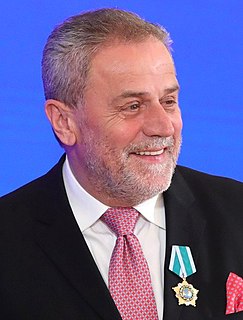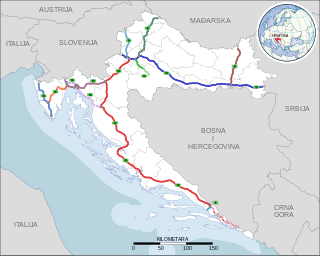
The demographic characteristics of the population of Croatia are known through censuses, normally conducted in ten-year intervals and analysed by various statistical bureaus since the 1850s. The Croatian Bureau of Statistics has performed this task since the 1990s. The latest census in Croatia was performed in autumn of 2021. According to final results published on 22 September 2022 the permanent population of Croatia at the 2021 census had reached 3.87 million. The population density is 68.7 inhabitants per square kilometre, and the overall life expectancy in Croatia at birth was 78,2 years in 2018. The population rose steadily from 2.1 million in 1857 until 1991, when it peaked at 4.7 million. Since 1991, Croatia's death rate has continuously exceeded its birth rate; the natural growth rate of the population is negative. Croatia is in the fourth stage of the demographic transition. In terms of age structure, the population is dominated by the 15 to 64 year‑old segment. The median age of the population is 43.4, and the gender ratio of the total population is 0.93 males per 1 female.

The economy of Croatia is a developing high-income service based economy with the tertiary sector accounting for 60% of total gross domestic product (GDP). Croatia joined the World Trade Organization in 2000, NATO in 2009 and became a member of the European Union on 1 July 2013. The Croatian economy was badly affected by the financial crisis which, together with slow progress of economic reforms, resulted in six years of recession and a cumulative decline in GDP of 12.5%. Croatia formally emerged from the recession in the fourth quarter of 2014, and had a continuous GDP growth since. The Croatian economy reached pre crisis levels in 2019, but due to the Coronavirus pandemic its GDP had decreased by 8.4% in 2020, growth picked up in 2021 when Croatia recorded biggest GDP growth since 1991.

The Armed Forces of the Republic of Croatia is the military service of Croatia.

The kuna is the currency of Croatia, in use since 1994. It is subdivided into 100 lipa. The kuna is issued by the Croatian National Bank and the coins are minted by the Croatian Mint. The plural form of the word kuna in Croatian can be kuna or kune because of different number declension rules. 2022 will be the final year for the kuna as Croatia will replace it with the euro on 1 January 2023. All Croatian bank accounts and credit cards will automatically be converted to euros and kuna cash may be exchanged for euros at no charge.

Jugoton was the largest record label and chain record store in the former Yugoslavia based in Zagreb, SR Croatia.

Milan Bandić was a Croatian politician and the longest-serving mayor of Zagreb, the capital of Croatia. Bandić was mayor almost continuously from 2000 to 2021, except during the time between his resignation in 2002 and the 2005 election. He was also suspended from exercising his powers and duties for several months after his 2014 arrest over a corruption scandal. Out of Bandić's multifaceted engagement in politics, the most noted part was his mayoralty of Zagreb, which followed the Croatian Democratic Union's (HDZ) first post-socialist period of government (1990–2000), and exacerbated many existing transitional problems in the city.

Hanza Media is the leading media company in Croatia and Southeast Europe, with 5 daily newspapers, more than 20 magazines, and 20 digital editions.

The A1 motorway is the longest motorway in Croatia, spanning 476.3 kilometers (296.0 mi). As it connects the nation's capital Zagreb to the second largest city Split, the motorway represents a major north–south transportation corridor in Croatia and a significant part of the Adriatic–Ionian motorway. Apart from Zagreb and Split, the A1 motorway runs near a number of major Croatian cities, provides access to several national parks or nature parks, world heritage sites, and numerous resorts, especially along the Adriatic Coast. National significance of the motorway is reflected through its positive economic impact on the cities and towns it connects as well as its importance to tourism in Croatia.

The A2 motorway is a motorway in the Hrvatsko Zagorje region of northern Croatia, connecting Zagreb to the Macelj border crossing and Slovenia. The A2 motorway is part of the European route E59 and the Pan-European Corridor Xa. The motorway spans 59.2 kilometres (36.8 mi) between the Slovenian border and the Jankomir interchange within the Zagreb bypass, providing road connections to a number of cities and towns besides Zagreb, including Krapina, Zabok and Zaprešić. All sections of the motorway, except the northernmost one between the Macelj border crossing and Trakošćan, and the southernmost one near Zagreb, are tolled, using a closed toll collection system.

Assicurazioni Generali S.p.A. or simply Generali Group is an Italian insurance company based in Trieste. As of 2019, it is the largest of its kind in Italy and among the top ten largest insurance companies in the world by net premiums and assets.

Geofoto is a Croatian company with 260 employees headquartered in Zagreb, Croatia with subsidiaries in Norway, North Macedonia, Slovenia, Bolivia, Argentina, United Arab Emirates, Czech Republic and United Kingdom. Its main fields are Geomatics activities such as photogrammetry and geographic information systems (GIS). In Croatia it has won a number of business awards.

Highways in Croatia are the main transport network in Croatia. The Croatian classification includes several classes of highways:

Adris Grupa d.d. is a Croatian diversified conglomerate based in Rovinj. It has more than 8,000 employees, and is one of the leading companies in the region, with an annual income of more than 5 billion kunas.

Energy in Croatia describes energy and electricity production, consumption and import in Croatia.

Hrvatska poštanska banka d.d. or HPB is the largest Croatian-owned bank in the country and ranks 6th in Croatia in terms of total assets, worth around HRK 21.25 billion.

Čakovečki mlinovi is a Croatian milling company based in Čakovec. In addition to being the biggest producer of wheat flour in the country, it also produces baked goods and pumpkin seed oil. The company's shares are listed on the Zagreb Stock Exchange (ZSE) and is one of the 25 companies included in its official share index CROBEX as of September 2010.
The Port of Rijeka is a seaport in Rijeka, Croatia, located on the shore of the Kvarner Gulf in the Adriatic Sea. The first records of the port date to 1281. It was the main port of the Kingdom of Hungary in the 19th century and the beginning of the 20th century, of Yugoslavia between World War II and 1991, and of Croatia after its independence. Today, it is the largest port in Croatia with a cargo throughput of 13.6 million tonnes (2020), mostly oil, general cargo and bulk cargo, and 344,091 Twenty-foot equivalent units (TEUs).

Novi Dvori of Zaprešić, or Novi Dvori of Jelačić, is a feudal estate in the northwestern part of Zaprešić, Croatia. The estate consists of a castle, an old granary renovated into a museum, a circular threshing machine, a neo-gothic chapel and the Jelačić family tomb.
The INA-MOL dispute was a dispute between the government of Croatia and MOL Plc., as to the management rights of INA d.d. MOL held the controlling interest in the company, while Croatian representatives maintained this controlling share was obtained illegally, through the bribery of the former Croatian prime minister Ivo Sanader. The dispute was brought before the United Nations Commission on International Trade Law, with the UNCITRAL ruling in favor of MOL.

















